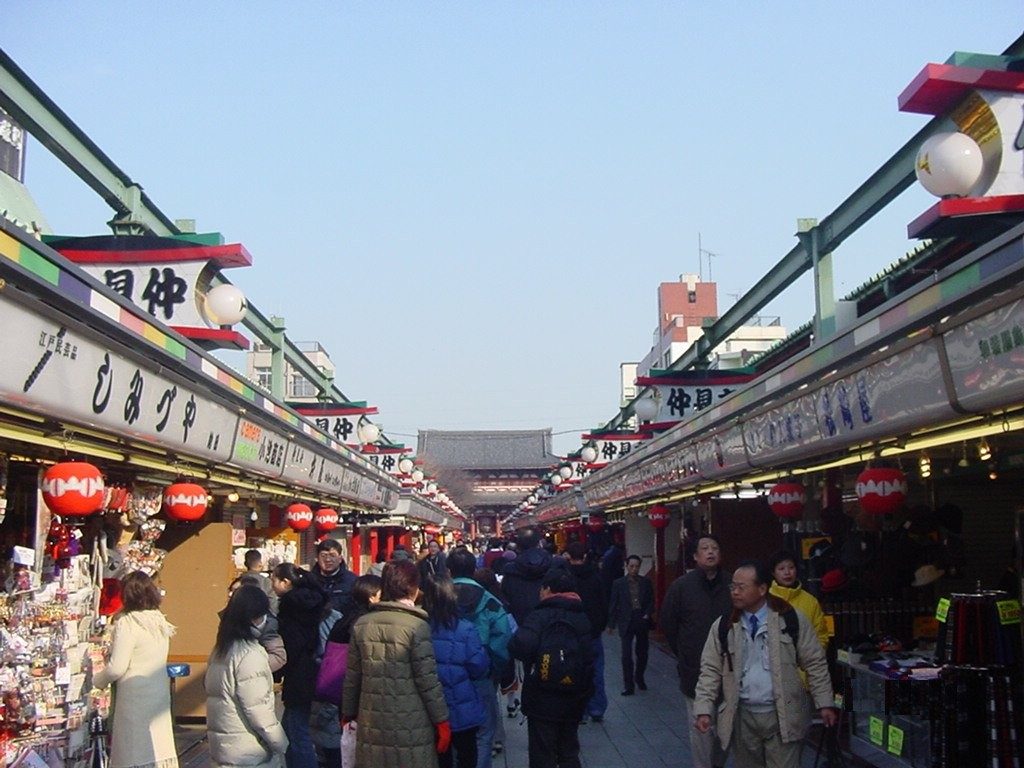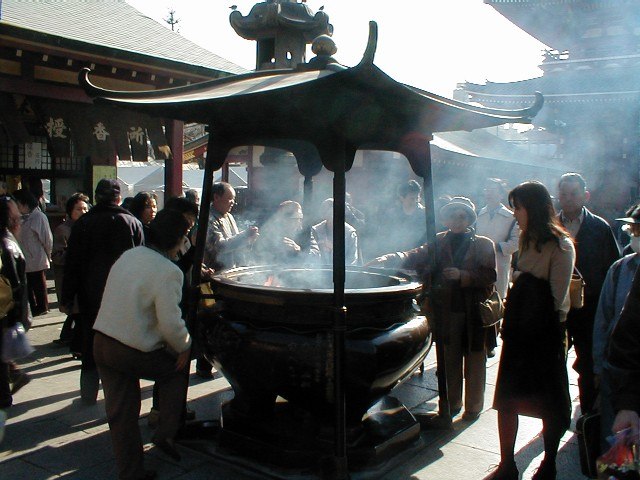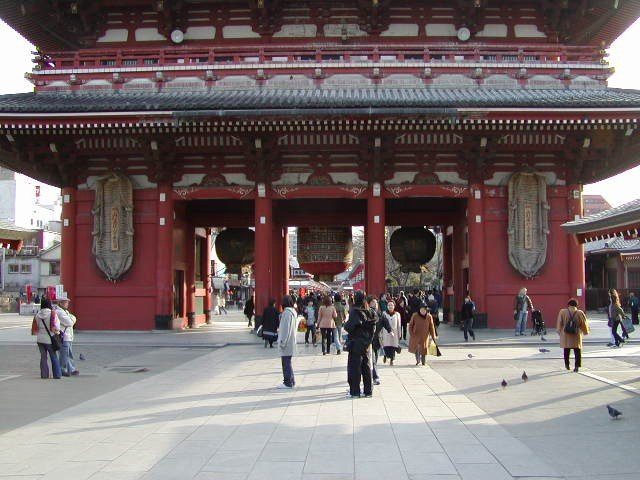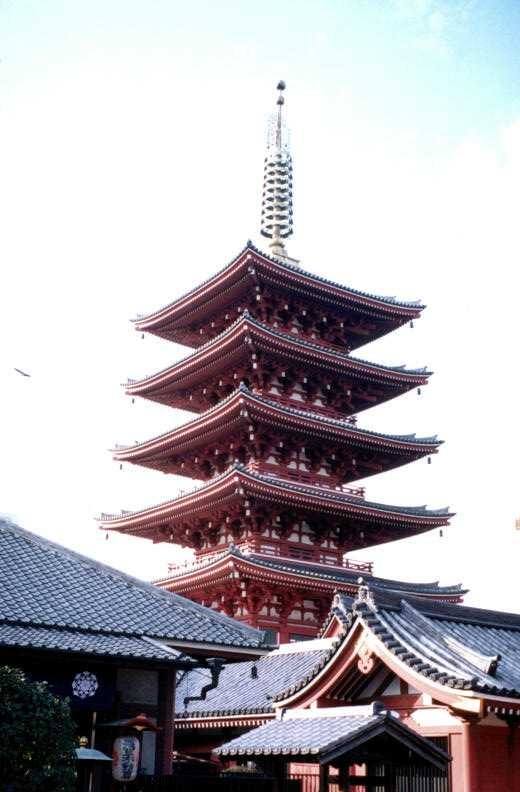

Asakusa Shrine
Asakusa Shrine was founded in
628 C.E. when
two brother, Hamanari and Takenari pulled a Buddhist statue out of the
Sumida River while fishing. The local chieftain took this as a sign,
began to practice Buddhism in earnest, and founded the Sensoji Temple
on the spot. The Asakusa shrine complex grew from these simple
beginnings, and now the site houses numerous temples. The photo to the
left shows the main entrance to the Askasusa complex, through the Kaminari-mon
Gate, while the photo to the right shows an interior view of that
entrance. The Kaminari-mon
gate leads to Nakamise
street, a bustling venue with shops on both sides, forming an entryway
to the Kannondo Temple. The photo to the bottom left is a shot
of Nakamise Street, looking back toward the Kaminari-mon gate.
Midway between the gate and the Kannondo Temple is a large urn,
shown in the photo to the lower right. The urn contains ashes, and is
used to burn paper


 The
heart of
the Asakusa complex is the Kannondo Temple, shown in the photo to the
left. Entrance to the temple is made through the Hozo Mon Gate, which
resembles the Kaminari-mon gate in structure, although a bit
larger and more ornate. The gate was once referred to as the Nio
Mon Gate because the statues of Nio, the Guardian diety of the
Buddha, are installed on the right and left side of the gate, as well
as paper lanterns dedicated by the local fisher markets in gratitude to
Tokugawa Ieyasu. (photo to the right). Moving inward from the Nio
Mon gate, is the Kannondo
Hall or Asakusa
Kannon.
There is a public
area and the inner Asakusa-Jingu. The photo at the lower left
shows people in the outer area making wishes and pitching coins for
good luck. The photo at the
bottom left offers a glimpse of the inner shrine.
There are in fact three shrines in the middle, main, and outer
hall, and they are transported
The
heart of
the Asakusa complex is the Kannondo Temple, shown in the photo to the
left. Entrance to the temple is made through the Hozo Mon Gate, which
resembles the Kaminari-mon gate in structure, although a bit
larger and more ornate. The gate was once referred to as the Nio
Mon Gate because the statues of Nio, the Guardian diety of the
Buddha, are installed on the right and left side of the gate, as well
as paper lanterns dedicated by the local fisher markets in gratitude to
Tokugawa Ieyasu. (photo to the right). Moving inward from the Nio
Mon gate, is the Kannondo
Hall or Asakusa
Kannon.
There is a public
area and the inner Asakusa-Jingu. The photo at the lower left
shows people in the outer area making wishes and pitching coins for
good luck. The photo at the
bottom left offers a glimpse of the inner shrine.
There are in fact three shrines in the middle, main, and outer
hall, and they are transported 
worshippers during the Shanja Festival. The photo at the bottom shows the Nite-mon Gate, the Shogun's entrance to the temple. This gate is on the east side of the Kannondo Hall.

 There are
other
temple temples more on the periphery of the complex. The photo to the
right shows Dempo-in (priest's residence) and Goju-no-To, the
Five Story
Pagoda, another center of worship. The pagoda contains the ashes and
memorial tablet of the Buddha, while the Denpoin Temple refers to the
main temple of the Sensoji Temple, and was a study and library for
priests. The photo to the right shows the Torii gate that leads to the
original Asakusa Temple. It is named after a priest who rebuilt the
temple.
There are
other
temple temples more on the periphery of the complex. The photo to the
right shows Dempo-in (priest's residence) and Goju-no-To, the
Five Story
Pagoda, another center of worship. The pagoda contains the ashes and
memorial tablet of the Buddha, while the Denpoin Temple refers to the
main temple of the Sensoji Temple, and was a study and library for
priests. The photo to the right shows the Torii gate that leads to the
original Asakusa Temple. It is named after a priest who rebuilt the
temple. Komagatado Temple: birthplace of the Sensoji temple, built on the spot where the Buddha was fished from the Sumida River
Yogodo Hall: built as memorial to Saint Jikaku, who rebuilt the Sensoji Temple
Yakushido Shrine: subordinate shrine build in Hosangen style
Awashimado Temple: commemorates those who hand-copied the sudra, and also features a tower for peace
Iizuko Jizo Hall: a hall for praying for prosperity; old coins are buried there
Chingodo Shrine: dedicated to guardian diety of Denpoin temple, the racoon dog, who guard the shrine
Bentensan: standing on a small hill, the goddess of this hall is called the Rojo Benten or old goddess because of her gray hair
Matsuchiyama Shoten: on the bank of the Sumida River
Henjoin/Daikannonji Temple: branch temples of Sensoji Temple. Henjoin Temple is in the 6th block of Asakusa, while in the Daikonnonji Temple the head of the image of Buddha of Shokannon made of Iron is installed as a principle image
360 Video Tour of Kannando Temple from Japan 360
[be sure to select the 4K or HD
setting]